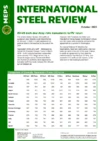Poland’s EU funding push could stimulate steel market
Central Europe’s steel industry could benefit from an uplift in activity if the Polish government succeeds in its bid to unlock almost EUR60 billion in European Commission funding.
The European Commission agreed a near-EUR60 billion recovery and resilience plan with the country’s previous government, led by the nationalist Law and Justice (PiS) party, last year. Access to the funds – part of the EU’s 2021-2027 budget – was subsequently blocked over concerns over changes made to Poland's legal system.
In December last year a new government, led by pro-EU Prime Minister Donald Tusk, was elected. The government received the first contribution from its previously blocked EU funding, amounting to around EUR5bn, later that same month. An application for a further EUR6.9bn has now been made and reforms could deliver access to much more.
Such a cash injection would provide a significant boost to the region’s steelmakers. Poland’s recovery and resilience plan stipulates that its multi-billion-euro cash injection will be used to modernise residential housing to improve its energy efficiency. An Offshore Wind Fund, meanwhile, will encourage private investment in large-scale renewable energy projects.
These developments may take time to come to fruition. However, they will add to hopes of a market revival.
Economic pressures
During February’s research period, steel market participants in Poland and neighbouring Czechia told MEPS that demand – particularly from the key construction and automotive sectors – remained weak in Central Europe. They continue to suffer the effects of reduced exports to Germany.
The German economy shrunk by 0.3% in 2023. Hamburg Commercial Bank’s (HCOB) Germany construction PMI, accessed via FactSet, was 36.3 in February, well below the 50-point divide between growth and contraction. HCOB’s Germany manufacturing PMI stands at 45.5, despite six consecutive months of improvement.
MEPS research partners indicate that the steel sector remains subdued in Poland and Czechia. Nonetheless, the countries’ economies show signs of greater stability.
In January, Poland’s rate of inflation declined to 3.9%, from 6.2% a month earlier – down considerably on the 18.4% level of January 2023. Czechia’s rate of inflation fell from 6.9% to 2.3%, its lowest level since March 2021.
Across Europe, a prolonged period of reduced inflation should open the door to interest rate cuts. This would free up finance and improve purchasing power, stimulating construction and retail activity.
Supply and demand ‘stalemate’
An increase in demand would apply upward pressure to steel prices in Central Europe. However, February’s research revealed a stalemate between the buyers’ cautious approach to purchasing amid low demand and the mills’ need to maintain prices due to elevated input costs.
Limited domestic supply has also served to consolidate the recent price increases, which continued in February. Liberty Steel’s production challenges at its Czestochowa, Dunaferr, Galati and Ostrava plants have reduced procurement options in the region. MEPS respondents suggest that US Steel Kosice has benefitted from the disruption, receiving healthy forward orders. Even that mills’ latest price rises have failed to gain traction with buyers, however.
Subdued demand is set to remain the defining feature of the European steel sector in the months to come. Poland’s potential EU funding, however, joins hope for a reduction in interest rates in delivering an uptick in sentiment about the steel market’s outlook.
- This content first appeared in the February edition of MEPS International's Stainless Steel Review. The monthly report provides subscribers with steel prices, indices, market commentary and forecasts from across the globe.

Source:
International Steel Review
The MEPS International Steel Review is an essential monthly publication, offering professional analysis and insight into carbon steel prices around the world.
Go to productRequest a free publication





